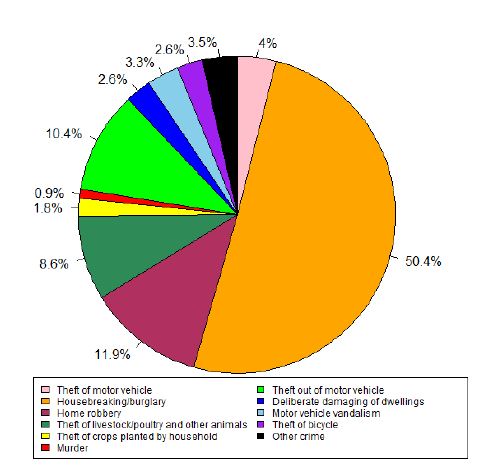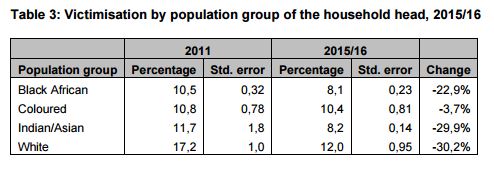Crime Statistics Series Volume 4
Exploring the extent of and circumstances surrounding housebreaking/burglary and home robbery
An in-depth analysis of the Victims of Crime Survey data
2015–2016
Executive Summary
The general crime rate in terms of the proportion of households that experienced crime has been declining during the last five years. All provinces except the Eastern Cape experienced a decline in the proportion of households that were victims of crime between 2011 and 2016. This reality has, however, not translated into positive perceptions about crime in the country. There has been a growing perception that crime is on the increase. People, as represented by household heads from sampled dwellings, were more afraid in 2015/16 to walk alone in the dark in their neighbourhoods than they were five years ago.
Over 50 per cent of all crimes experienced by households in South Africa in 2015/16 were housebreaking. Home robbery was the second (11,9 per cent) most common type of crime experienced by South African households. Whites had the highest rates of victimisation compared to other groups both in 2011 and 2015/16. However, whites experienced the sharpest decline of household related crimes during the five years, when considering the proportion of households that experienced crime.
Housebreaking and home robbery peaked during the months of March and June in both 2014/15 and 2015/16. The months where crime was least likely to occur were January, May and November. As found in previous VOCSs, night-time is still the most preferred time for crime incidents.
Electrical equipment were the most targeted items during both housebreakings and home robberies. Jewellery, money and cell phones were the second most common items stolen after electrical equipment during both housebreaking and home robbery.
The reporting rate of home robberies to the police was significantly higher than that of housebreakings, possibly because home robbery is a more serious crime. The conviction rate among those arrested was 14,3 per cent for housebreaking, and 22 per cent for home robbery. An arrest is made in only one out of every five reported cases of housebreaking or home robbery. Only one in five people arrested for housebreaking was convicted, and one in three people arrested for home robbery was convicted.
Households that did not secure the arrest of perpetrators after reporting the housebreaking to the police, were more likely to be dissatisfied with the police compared to those where perpetrators were arrested. There is no evidence that dissatisfaction with the police service caused people to report crime to other authorities. Robberies tend to be reported more to the police than to other authorities.

Results from modelling show that gender, educational level, presence of community crime prevention forums, distance to police stations and the response time of the police are significant predictors of housebreaking. The absence of community crime prevention forums, long distances to police stations and long police response times to emergency calls are all factors that increase the odds of housebreaking. The implication of this finding is that the promotion of community crime prevention forums, building more police stations closer to the people and improving police response times are some of the interventions that could help reduce housebreaking.
A lack of expectation of police arriving when called during an emergency is associated with the highest odds of home robbery, while shorter distances to a police station can be associated with smaller odds of home robbery.
Race, education level and distance to the police station are the only significant predictors of the odds of reporting housebreaking. The results show that the odds of a white-headed household reporting housebreaking are significantly higher than those of a black African-headed household (black African was the reference race in this analysis). Education level 3 (post-matric qualification but less than a bachelor’s degree) also has significantly greater odds of reporting housebreaking compared to households headed by persons without schooling. When the police station is more than two hours away, the odds of not reporting housebreaking are high, and vice versa.
The same variables – race, education level and distance to police station – are significant predictors of the odds of reporting home robbery. Non-existence of a community crime prevention forum is another significant predictor of the odds of reporting home robbery to the police.
SAPS crime statistics show that total crime as a percentage of the population (per capita crime) has been steadily decreasing since 2005. However, the rate is too slow. At this rate, the goal of eliminating crime will be achieved in 2059 instead of in 2030, as envisaged by the National Development Plan (NDP 2030). VOCS national crime estimates are different from the crime data produced by the SAPS. At provincial level, however, there is agreement between the two sources of data for most of the provinces.
The full report can be accessed here.


